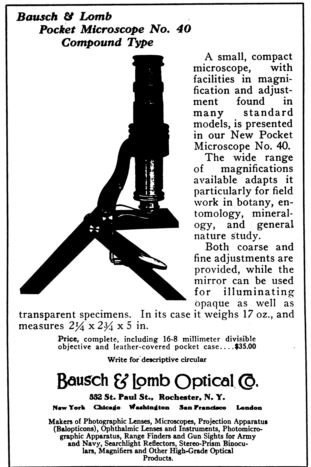POCKET MICROSCOPE NO. 40
MAKER: BAUSCH & LOMB
c. 1922-1932 (1924)
SERIAL NO.: 170176
DESCRIPTION:
This good quality 'pocket' microscope is made of black painted brass. The serial number is engraved on one of the legs of the folding tripod and corresponds to 1924. It measures about 4.6 x 2.4 x 1.8 inches (117 x 60 x 46mm) when folded up and is about 25.5cm (10 inches) high in working position. The case measures about 5 x 2 3/4 x 2 1/4 inches(254 x 51 x 57mm). It has a single eyepiece and a divisible objective. There is a single concave substage mirror and no condenser. Coarse focus is push-pull and fine via a knurled ring working on the main optical tube within it. The maximum magnification with draw tube extended is about 250X. The mirror can detach from the substage holder and attach to a pin on the side of the limb for top illumination of opaque objects.
 As is shown in the sequence, preparing the microscope for storage is quick and straightforward. The legs fold next to each other and back against the microscope. The drawtube is pushed all the way in, and the optical tube pushed down so that the objective is even with the stage. The rod supporting the mirror is pushed up into the limb of the microscope, so that the mirror comes to rest against the bottom of the stage.
As is shown in the sequence, preparing the microscope for storage is quick and straightforward. The legs fold next to each other and back against the microscope. The drawtube is pushed all the way in, and the optical tube pushed down so that the objective is even with the stage. The rod supporting the mirror is pushed up into the limb of the microscope, so that the mirror comes to rest against the bottom of the stage.
HISTORY OF THIS MICROSCOPE
 This microscope was, according to the company, first produced in 1922. It was first reported that same year in the Transactions of the American Microscopical Society, V16, pp193-194, following an article about the Hensoldt Tami microscope. It was also advertised in the advertising section of that periodical as shown to the left. It bears a striking resemblance to the Beck
This microscope was, according to the company, first produced in 1922. It was first reported that same year in the Transactions of the American Microscopical Society, V16, pp193-194, following an article about the Hensoldt Tami microscope. It was also advertised in the advertising section of that periodical as shown to the left. It bears a striking resemblance to the Beck Baby London Microscope
which was reported only two years later. The major difference between the two is the method of fine focus; the Baby London uses a tilting stage fine focus actuated by a knob at the rear, whereas the B & L Pocket model uses a knurled ring around the housing for the optical tube and acting directly on that, similar to the Leitz Minor
which was produced starting about 1924, the same year as the Baby London came out.
 As is shown in the sequence, preparing the microscope for storage is quick and straightforward. The legs fold next to each other and back against the microscope. The drawtube is pushed all the way in, and the optical tube pushed down so that the objective is even with the stage. The rod supporting the mirror is pushed up into the limb of the microscope, so that the mirror comes to rest against the bottom of the stage.
As is shown in the sequence, preparing the microscope for storage is quick and straightforward. The legs fold next to each other and back against the microscope. The drawtube is pushed all the way in, and the optical tube pushed down so that the objective is even with the stage. The rod supporting the mirror is pushed up into the limb of the microscope, so that the mirror comes to rest against the bottom of the stage.
 This microscope was, according to the company, first produced in 1922. It was first reported that same year in the Transactions of the American Microscopical Society, V16, pp193-194, following an article about the Hensoldt Tami microscope. It was also advertised in the advertising section of that periodical as shown to the left. It bears a striking resemblance to the Beck
This microscope was, according to the company, first produced in 1922. It was first reported that same year in the Transactions of the American Microscopical Society, V16, pp193-194, following an article about the Hensoldt Tami microscope. It was also advertised in the advertising section of that periodical as shown to the left. It bears a striking resemblance to the Beck